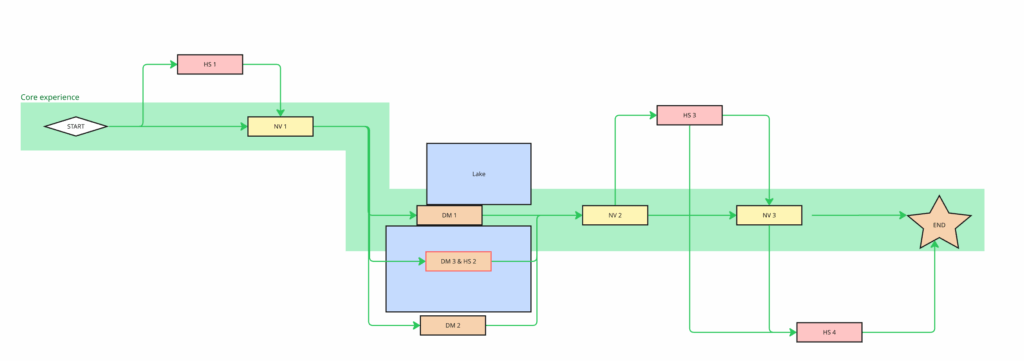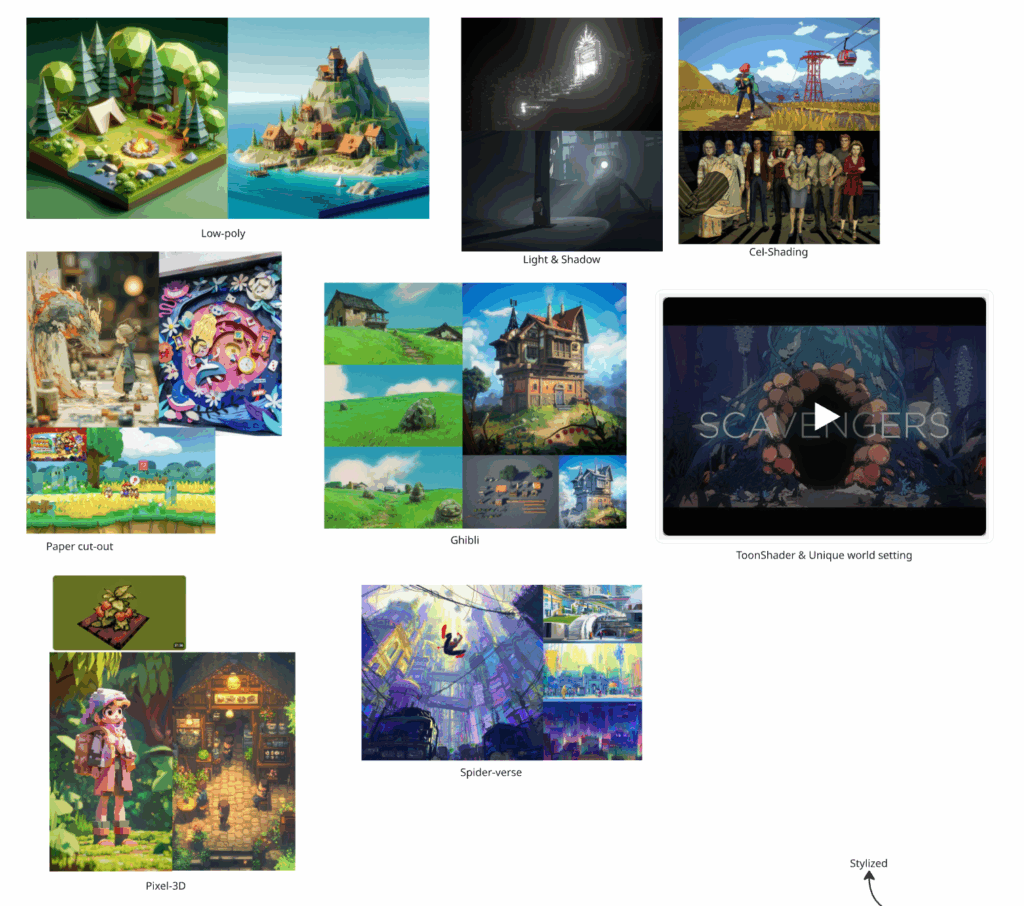Design Meeting
After our brainstorming and workshop in Week 1, we started shaping a clearer idea of the kind of experience we want to create for our guests. Since we are still exploring different technologies and haven’t settled on an engine yet, we agreed that the experience needs to be simple while still captivating.
Through several discussions, we narrowed our ideas down to two possible directions. The first is a narrative-driven “story of life,” where we guide guests through a hiking journey enriched with storytelling. The second is a meditative “path of scenery,” which focuses more on the environment, views, and reflective moments.
To support these ideas, we created a rough map and user journey. This will help the art team start visualizing the space and dive deeper into researching what kind of landscapes we want to bring into the project.

Map & User Journey

Dynamic moments art references
Prepping for 1/4s

With our core experience defined, we shifted our focus this week toward preparing for our upcoming Quarters presentation. This presentation is a key milestone for us, as it not only allows us to share our progress with faculty and peers but also helps us clarify our goals, identify challenges, and gather valuable feedback that will guide the rest of the semester.
On the technical side, our team carried out several rounds of testing with different tools and devices. Some of the technologies we explored were only compatible with Unreal Engine, while others seemed to work better with Unity. This has been a challenge, since the choice of engine will affect nearly every part of development. For now, we are keeping both options open while we continue testing. To avoid being locked into a single direction too early, we also made sure that our early work, including prototypes and art assets, can migrate between engines if we eventually need to switch. This flexibility has been important for us, as our project heavily depends on foot-tracking technology and we want to ensure that our final decision is based on stability and performance rather than convenience.

The art team took a deeper dive into visual research this week. We explored different art styles that could match the tone of the experience and also tested small prototypes in engine to see how these styles might feel in VR. Beyond just the aesthetic appeal, we also studied the production pipeline, understanding what steps, tools, and workflows are required to achieve certain looks, and how feasible they are within the scope of our semester project. The goal is to land on a style that is both beautiful and achievable, while also supporting the type of emotional experience we want to deliver.
At the same time, we began refining our design documentation. Although we have a general direction, a VR hiking experience, we recognized that we were still a little lost when it came to focus. Without a fully confirmed technology pipeline, it can be difficult to anchor design decisions. To address this, we revisited our two main design directions: one leaning into a narrative-driven journey that tells a “story of life” as the guest hikes, and the other focusing on a meditative “path of scenery” that emphasizes the beauty of the environment. We created a rough map and user journey for each version, which not only gave the art team a starting point for visual research but also helped us clarify what kinds of interactions and pacing might be required.
Preparing for Quarters has been as much about refining our message as it has been about refining our work. We want to communicate clearly what we have achieved in these first few weeks, what decisions are still in progress, and what risks we are facing. Even though we don’t yet have our ideal tech solution in hand, we see this presentation as an opportunity to be transparent about where we are, what we’ve learned, and how we plan to move forward.
Tech Test
Good news:
- Worked.
- Implementation is not very difficult.
Bad news:
- Barely any documentation for this model.
- Only one function (moving forward) worked. Other functions didn’t.
- Loco S (the model we have) is NOT listed as supported in the SDK.
- The plugin for engine is not ready-to-use. May need a lot of efforts getting it to work.
Our Main Challenge
No ideal tech at hand.
Tech to be expected:
- Brilliant Sole: before halves?
- Omni-directional treadmill: within a month?
- OptiTrack: large space & long setup
How will we design for current tech to make it transferable to later tech?
Our Next Step
Art
This week the art team is finalizing the visual style and starting work on the poster and half-sheet as concept examples. They are also running quick art tests in the engine to see how the style translates in practice.
Design
The design team is focused on refining and polishing the core game experience, with the goal of having a stronger version ready by the end of the week.
Tech
On the tech side, the team is testing the project on new devices and preparing a test build to evaluate overall performance.
Questions We Have
Would feeling the tracking device impact the immersion?
Should the experience be modified depending on the user’s fitness level?
How much do you want the experience to be tied to reality?